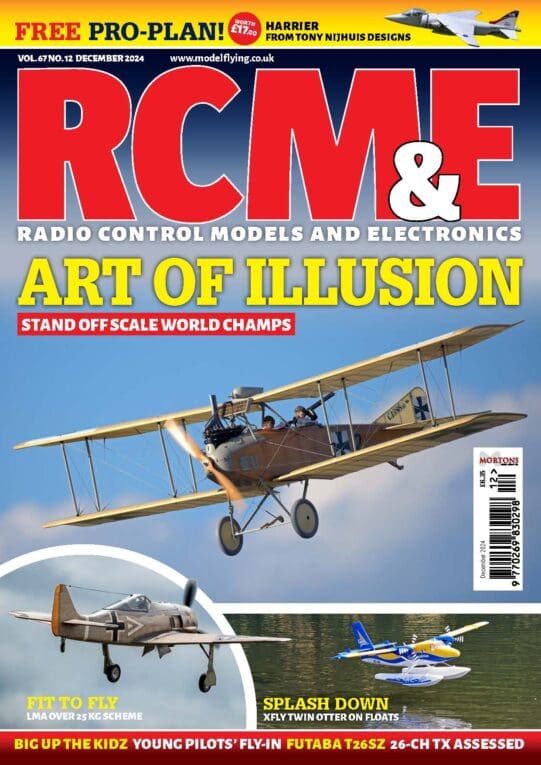The little LCD gives system info (see below)
Acme, the German producers of the original Flycam reviewed by Tim Mackey on the Modelflying forum have just brought out version 2 and being a sucker for this sort of thing, I pre-ordered one from Robotbirds to make sure I had one as soon as they got here and in the hope that what was already a brilliant bit of kit could be improved upon. I was not disappointed.
As can be seen, this is a very smart device in black and silver. There is no awkward mirror because the lens is able to rotate through 90-degrees. Thus the camera can be orientated to look straight ahead or straight down or use any angle in between. What’s more, a removable control horn is supplied so that it is possible to alter the camera view whilst airborne!
Enjoy more RCM&E Magazine reading every month.
Click here to subscribe & save.
The camera is slightly heavier at 37g, it is powered by a 220mAh Li-Po and takes a 2GB SD memory card. It is supplied with a mini connector USB lead rather than a dongle-type connection as before.
Another welcome change is that the controls are on the side, and easily accessible when the camera is mounted on its custom mount. (You had to remove version one to switch it on or to make adjustments) There is also an LCD screen to show the current status of the camera. In the picture above the status is VR (Video record) You are able to switch between camera modes with the top button, and start filming with the trigger button. This is very easy and intuitive. The other modes are:
…so you can see there is quite a lot of stuff that was not there in the first version. The spy stuff (which I wont go into) presumably is something to do with security and is activated from the front of the camera. In my opinion the most interesting addition is the ability to take 1280×1024 still frames every three seconds while flying. I look forward to exploring the possibilities of this.
The camera is supplied with a sturdy clip-on mount, which can be velcroed to your aircraft, a safety cord is also provided in case the Velcro lets go! The mount is ‘active’ and has a servo cable input socket. This allows the camera to be powered by an external supply or by your receiver battery, rather than rely entirely on the internal chargeable Li-Po battery. More interesting still – there are also two data inputs which allow the camera to be controlled externally. These contacts have not been documented in the manual yet so I have joined the forum at Flycamone.com (relying heavily on Google translator) to try and find out what is going on. I shouldn’t think it is rocket science, probably a 2-bit binary code giving four options, video start, photo trigger etc
 The mount and control horn can be seen here
The mount and control horn can be seen here
Where the camera really shows its superiority above the first version is when you start to use it. The UI is intuitive and easy to use, which is just as well because the manual, in four languages, on a tiny leaflet, is 100% unreadable. You need to download the manual from www.flycamone.de and print it out full size if you are to get anywhere.
The resolution is twice that of version one, meaning that frames and photos are four times the size. The resolution for video is 640×480 which gives excellent full-screen video. The still photos are 1280×1024 which is good enough for you to submit your imagery to Google Earth!
The focus of the tiny lens is much better than version one, and the video is noticeably sharper. The auto exposure is much quicker and this is needed if the camera is blinded by the sun at any time in the flight. This is illustrated quite well in the video I took of Portland Lighthouse (below). FlyCamOne V1 also has a problem with white balance that has been commented on from time to time in forums such as this. It tends to have a green tinge when the auto-exposure does not recover completely. Version 2 seems to have overcome this issue well.
Anyway, on a calm day in December (we don’t get many of those at Portland Bill) I mounted the camera on my little park-flyer, the E-Flite Gypsy and took it down to the lighthouse to see what we could do. I mounted the camera sideways so that I could do left hand circuits round the lighthouse without having the prop interfere with the video. The result was remarkably good given the watery winter light and the very low sun angle.
 Safely tucked away, my E-Flite Gypsy didn’t have a problem carrying the camera
Safely tucked away, my E-Flite Gypsy didn’t have a problem carrying the camera
All in all I would recommend this equipment very highly to anyone wishing to get into this fascinating aspect of our hobby. And as for me, I aim to take some film at our new indoor flying club. The camera is small enough to be carried by the lightest of models. I also want to try gyro stabilisation, although there may be a problem there with accumulated error without any reference. Any ideas? It may be better to stabilise the plane with an autopilot. If you’ve any comments then use the forum link below where we can chat all things FlyCamOne. Don’t forget to check out my video below.
DATAFILE




